Opportunity Lost: The Cost of Rescinding the International Entrepreneur Rule
Date: June 27, 2018

Introduction
The American Dream has long provided hope to millions that a better life in America is possible through hard work, ingenuity, and an entrepreneurial spirit. For those leaving or fleeing their homelands for a new life in the United States, this is especially true. This hope is fueled by countless stories of immigrants who started from scratch and ended up creating prosperity from nothing. One needs only to look at the country’s largest and most successful businesses to see this—more than 40 percent of American Fortune 500 companies were founded by first- or second-generation immigrants.[1] It is this track record that has sustained America’s reputation as a land of opportunity that attracts the best and brightest talent in the world.
Despite this history, U.S. immigration policies remain conspicuously ambivalent to the task of welcoming the most promising entrepreneurs from other countries. While this perhaps was unnecessary when the United States was the destination par excellence for entrepreneurs, mavericks, and investors from around the world after World War II, this is simply no longer the case. Today, many other countries are acutely aware of the increasingly competitive global labor market. Nearly every other developed economy in the world has taken proactive steps to attract skilled and entrepreneurial immigrants by establishing dedicated immigration programs for start-up founders. For example, the United Kingdom, Singapore, Ireland, New Zealand, and Chile have set up programs to systematically identify promising entrepreneurs and to offer them clear avenues to settle and establish their businesses within their borders.[2] In contrast, the United States has no visa for immigrant entrepreneurs who want to come here, start a business, and create jobs.
Instead, entrepreneurial immigrants in the United States are forced to navigate a complex set of different visa programs in the hopes they can find a way allowing them to stay and establish their business by the book. This lack of a clear path for business creators may have significant negative implications for the continued dynamism of the U.S. economy. Significant research has already shown that startups and young firms are the main drivers of new job creation in the United States.[3] Other studies, meanwhile, have found that immigrants are nearly twice as likely to start new businesses.[4] Taken together, research strongly supports the argument that creating dedicated pathways for immigrant entrepreneurs is of paramount importance to the continued economic vitality of the United States.[5]
The Department of Homeland Security’s (DHS) regulatory measure to give foreign entrepreneurs a chance to grow their firms in the United States, called the International Entrepreneur Rule (IER), was a first step in remedying this situation.[6] The IER allows potential business owners who show exceptional promise and solid capital investment—in most cases, raising hundreds of thousands of dollars of outside funding—to settle in the United States for an initial period of two and a half years. To extend beyond that, such firms must have achieved demonstrable success, specifically by raising at least $500,000 in additional funding, generating that much in annual business revenue, or creating at least five full-time American jobs.[7] However, despite the inherent job-creating potential of the IER, its future remains uncertain. Despite receiving widely positive press coverage and ample supporting public comments, DHS first delayed the implementation of the rule, and then later announced its intent to rescind the rule altogether.[8]
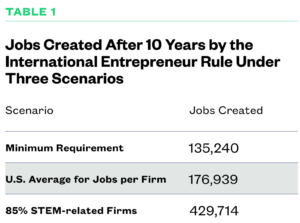
It is easy to understand that this rescission would have generally negative economic impacts on the U.S. economy. But in order to provide more specific notions of the potential cost of DHS’s decision, NAE estimated the potential impact on U.S. job creation over 10 years as well as its broader implications for the economy. To allow for a range of possible outcomes, NAE produced three scenarios, each based on a different set of assumptions based on past research, the government’s own estimates, and publicly available data (See Table 1).
In the first, we examine the baseline minimum as written in the IER filing itself, showing that even under the most conservative assumptions, the IER as written provides a minimum number of jobs for U.S. workers. In the second scenario, data on average number of jobs created per firm is taken from the U.S. Census Bureau’s Business Dynamics Statistics and used to model the number of jobs created assuming that IER-recipient firms behave like average U.S. businesses of the same age. Finally, given that the government estimates that a vast share of the IER beneficiaries will be active in STEM-related firms, the last scenario incorporates research findings on job creation specifically among technology-related firms and projects the total job growth. Then, to provide an idea of how the rescission of the IER will result in the loss of billions of dollars of additional value to the U.S. economy, the total direct and indirect benefits under all three scenarios of the rule are calculated using a set of well-established multipliers from the Bureau of Economic Analysis.
Scenario 1: Minimum Required
To provide a baseline, conservative estimate of the job growth effects of the International Entrepreneur Rule, the first scenario assumes that firms will generate only the minimum number of jobs required by the rule. The minimum requirement, per the IER filing, is five jobs over two and a half years. In addition to stipulating the minimum terms of IER parole, the DHS also provided its own projections of how many applications would be eligible for IER status—a total of 2,940 entrepreneurs each year.[9]
As it is not possible to say when the jobs would be created during the two-and-a-half-year period, the model assumes that the new jobs are created evenly throughout. Given these conditions, as seen in Table 2, the first two years see increasing total job growth by IER firms as the program ramps up, then a levelling off as IER beneficiaries phase out of IER status to be replaced by new ones. As such, once past the three-year mark, still assuming the minimum required, the IER program should create 14,700 new jobs every year. At the end of 10 years, this scenario results in a total of 135,240 jobs created as a result of the IER.
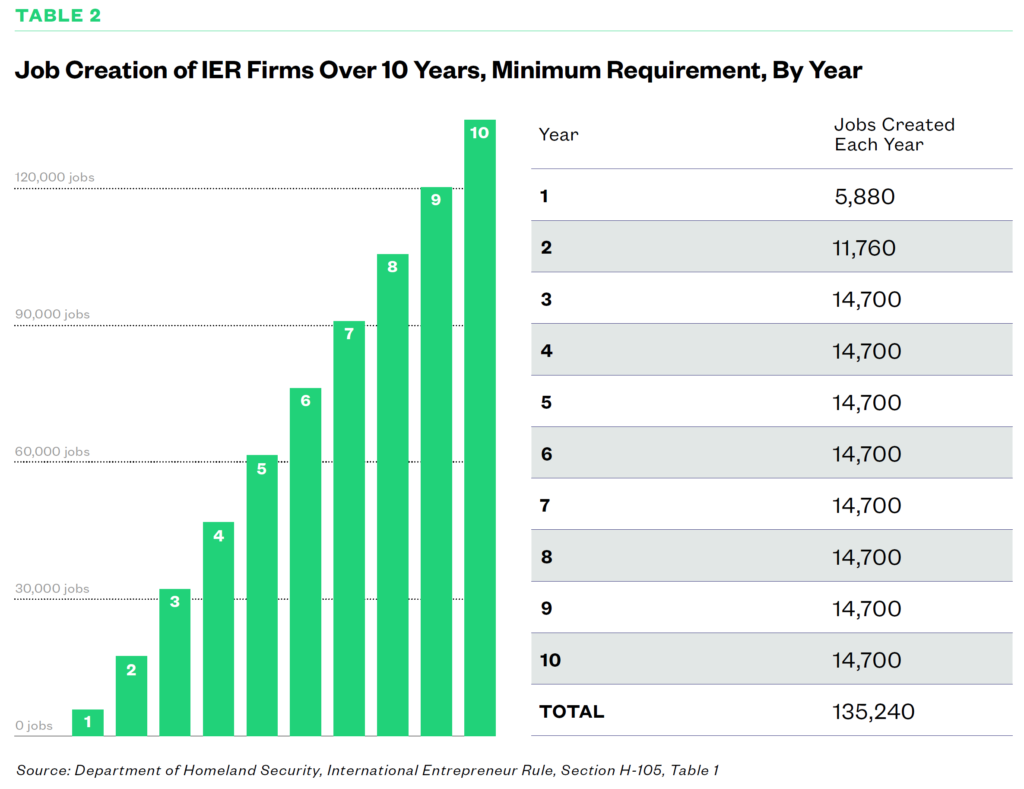
Scenario 2: Assuming U.S. Average Firm Job Growth
In the first scenario, it was assumed that firms would create the minimum number of jobs they needed to qualify for IER status. This assumption, however, is not based on past data on how new businesses in the United States actually perform or behave when it comes to job creation.
To model this, the second scenario incorporates data from the Business Dynamics Statistics (BDS) database from the U.S. Census Bureau. BDS data shows that the average three-year-old U.S. firm employs 8.85 employees.[10] As to not over-count the number of jobs created, the employment of the firm’s founder is accounted for and subtracted from this total. As such, this model assumes that each IER firm would create 7.85 jobs in addition to their founder. Applying this number to the pool of eligible firms and discounting it so that the total only reflects jobs created during the 2.5 years of IER status, the total number of jobs in the United States created in 10 years reaches about 176,939. These totals can be seen in Table 3.
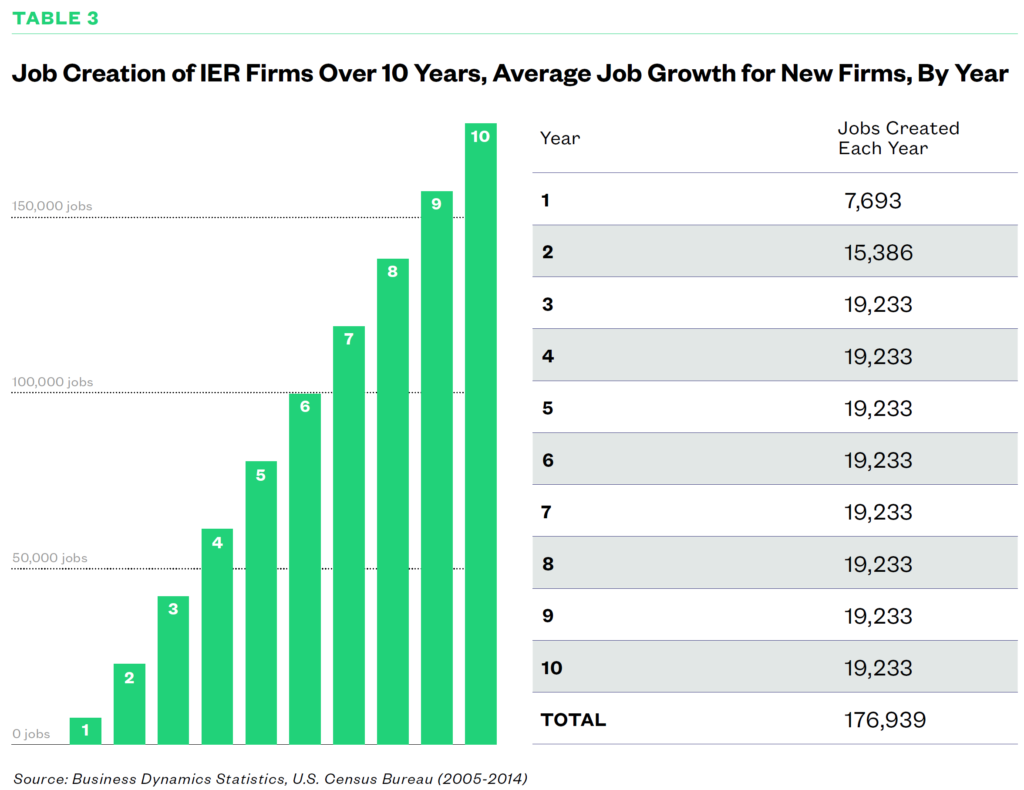
Scenario 3: Assume Average Job Growth Specific to STEM Firms
Rather than assume that all IER firms are the same and will perform as average U.S businesses, the third scenario instead uses the DHS’s own estimates on industry distribution of IER firms in order to provide a more nuanced look at their job creation potential. According to the DHS filing, the vast majority—approximately 85 percent—of IER firms would be technology or STEM-related firms.[11] Using research findings from Wadhwa et al. (2012) that found that STEM-related firms created far more jobs—21.37 jobs over three years—than other firms, the third scenario shows that a total of 409,428 would be created by these STEM IER firms over 10 years. For the remaining 15 percent of IER firms that are not STEM-related, NAE assumes that they perform, as in the second scenario, as average U.S. firms of the same age. Over 10 years, this minority of IER firms would result in 20,286 jobs. Together, the STEM and non-STEM IER firms would produce an impressive 429,714 jobs over the course of 10 years.
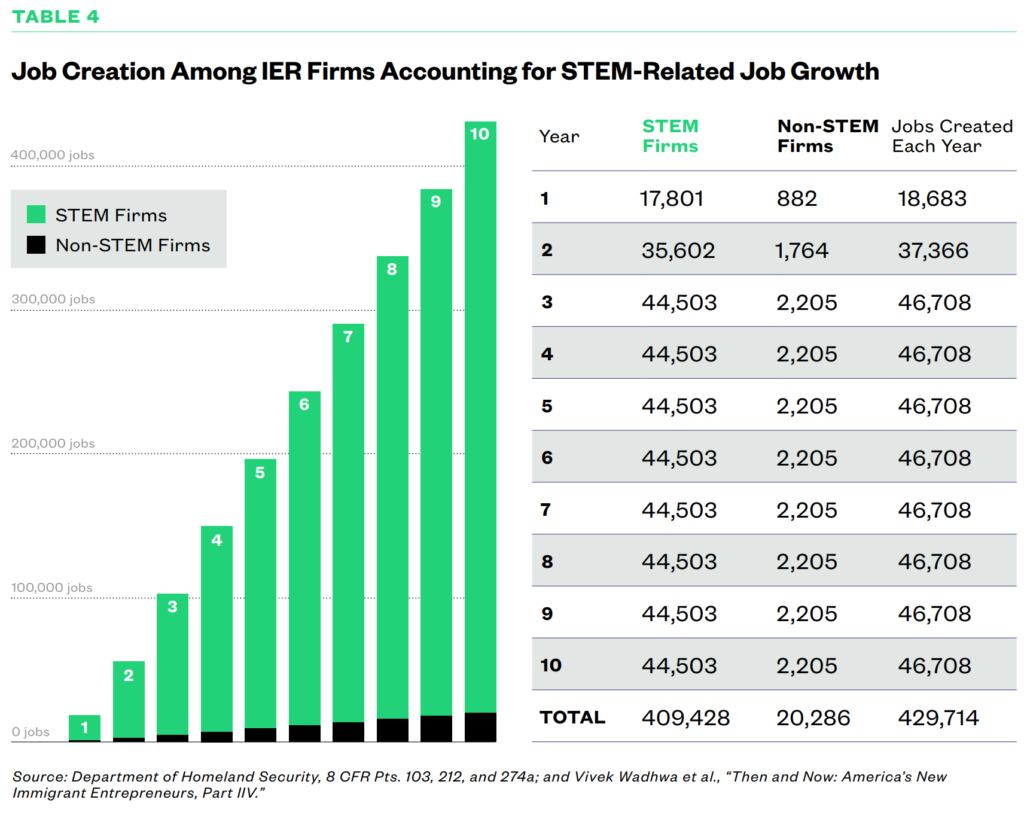
Beyond Job Creation
Jobs are not created in a bubble. The interconnectedness of the domestic economy means that the creation of a single job has positive indirect impacts at a local and even a national level. The increased consumer spending of newly employed workers creates additional economic activity that creates even more economic activity as the demand for goods and services triggers increases in demand for other goods and services. The indirect effects throughout the economy can be just as significant economically as the direct effects of paying a worker a wage. To estimate the full impact of even our most conservative estimate, we turned to a trusted set of tools from the Bureau of Economic Analysis: the RIMS II multipliers. These multipliers are used for a vast range of cost-benefit and economic impact modeling estimates by public and private sector entities. The multipliers estimate the total direct and indirect economic impacts of increased spending or increased employment in a given sector or industry. Using the same DHS estimates for the industry distribution of IER firms and using average industry wage data from the Bureau of Labor Statistics, it is possible then to apply the RIMS II multipliers in order to estimate the total direct and indirect benefits of the IER. Applying the figures from each of the scenarios above, the results show that in each projection, the IER would create anywhere from $5.8 billion for the U.S. economy over 10 years in the first scenario, to almost $18.5 billion over 10 years in the third scenario. (See Tables 5-7)
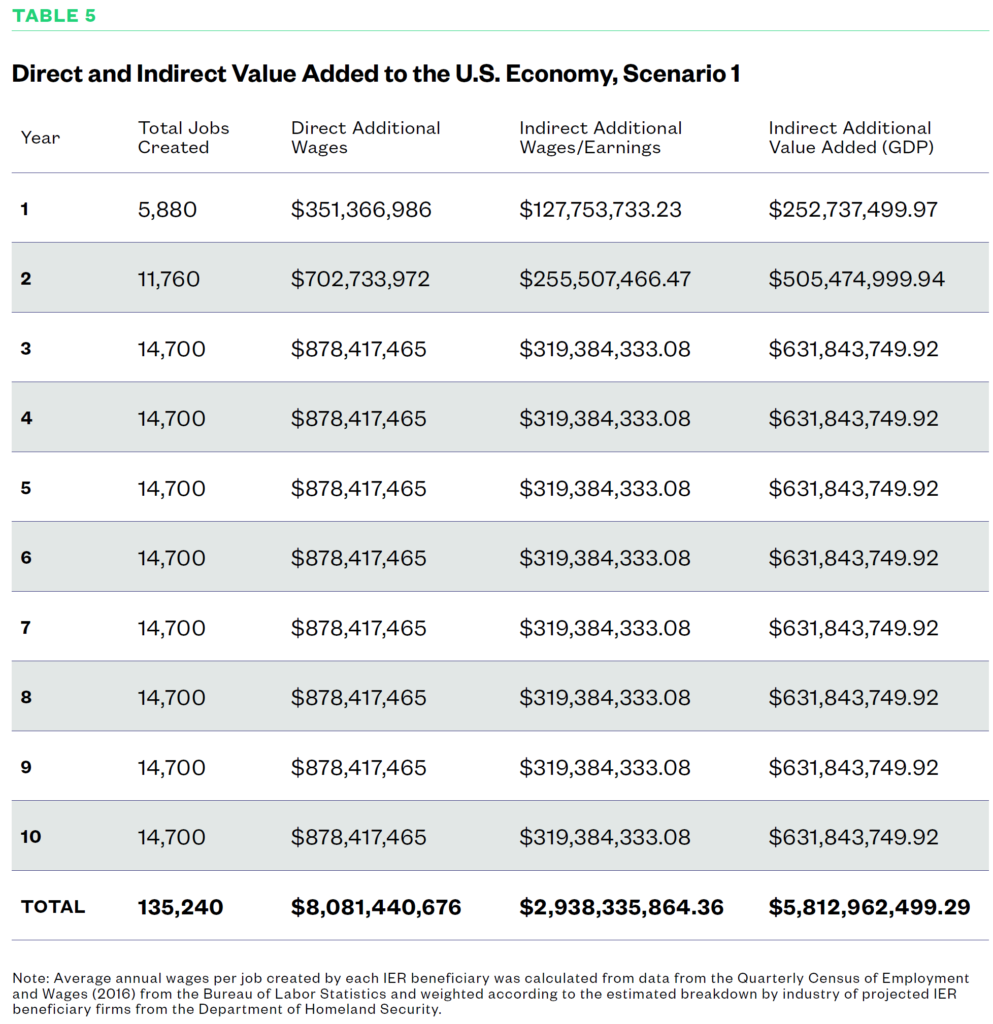
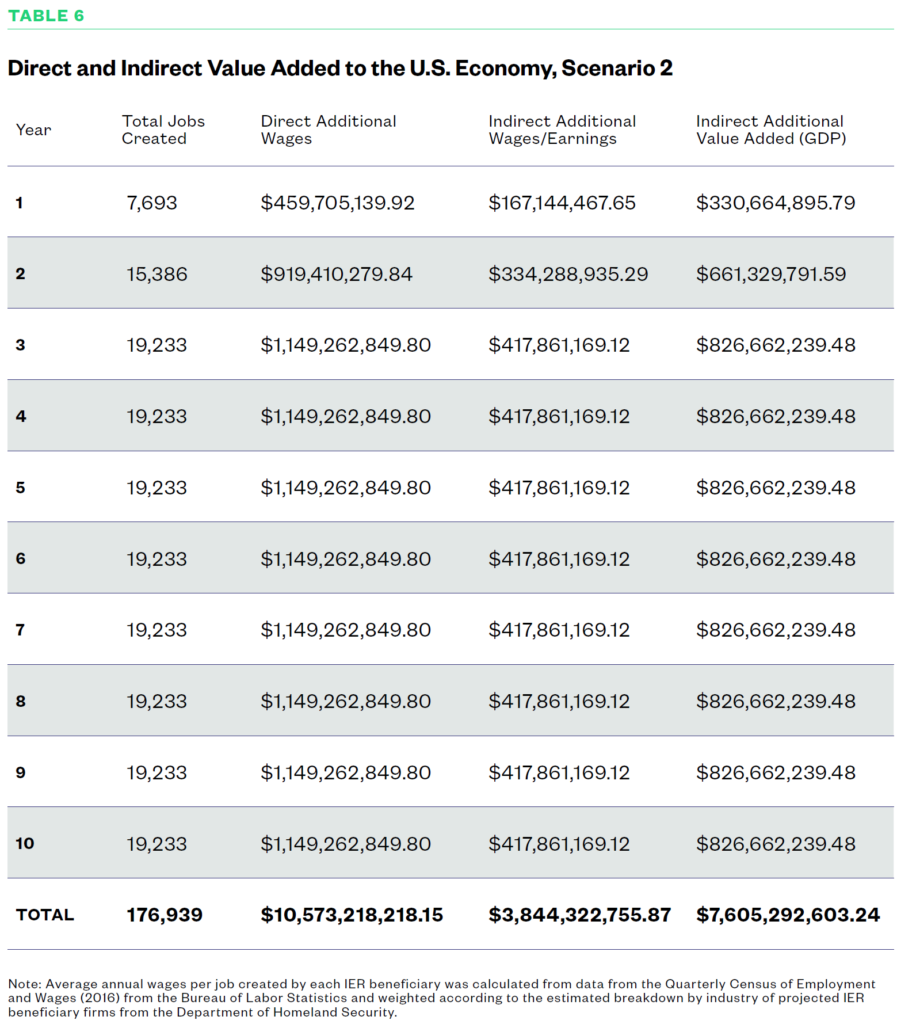
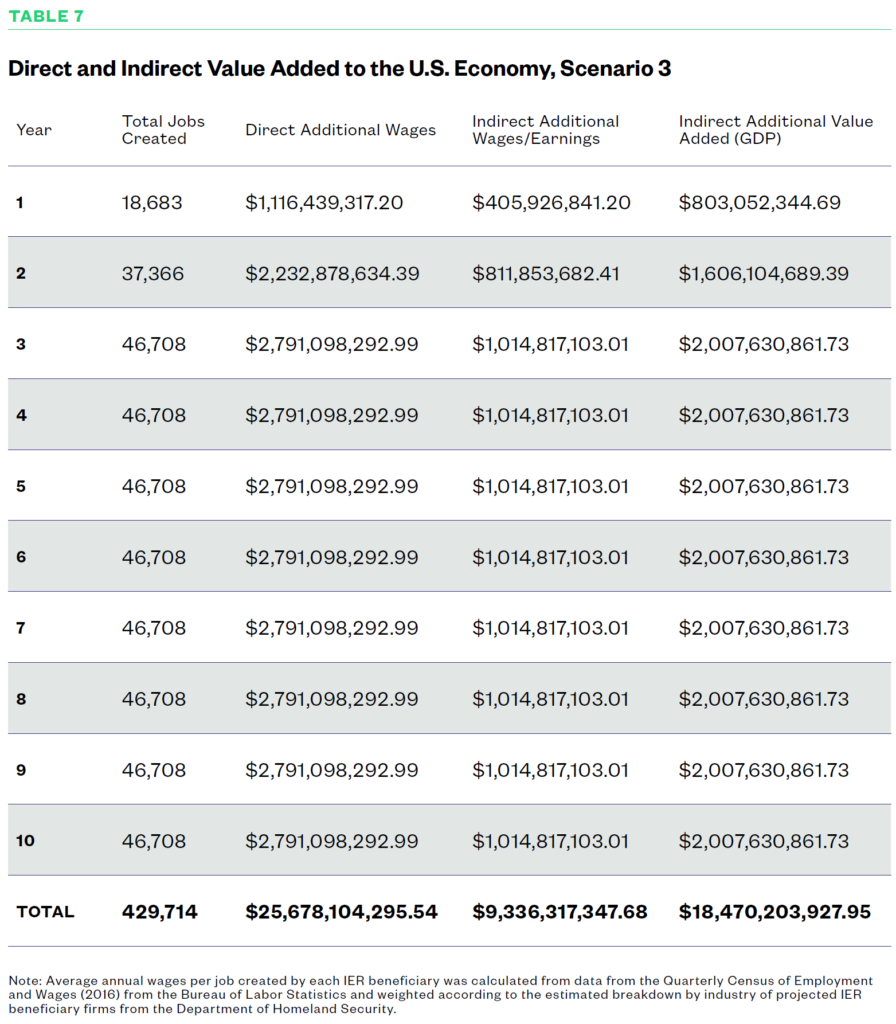
Conclusion
Given this range of job creation outcomes, it is clear that keeping the IER on the books and allowing it to be implemented would be a win-win for the U.S. economy. To put these findings into more context, the second, middle-range estimate shows that the IER would produce more jobs than the number of people GE employs in the United States—roughly 131,000 people.[12] In the third scenario, the total number of jobs created reaches more than 429,000 workers, almost 50 percent more than the number of taxi drivers and chauffeurs working in the entire country in 2014.[13] Beyond this, many see IER as having other less tangible benefits—including ensuring the United States remains a top destination for the best and brightest minds in business in the coming decade, boosting our ability to compete on the global stage, and keeping a small part of the American Dream alive.
Additional Methodology
Calculating Direct and Indirect Impacts to U.S. GDP
In order to estimate the increase in economic output due to implementation of the IER program, NAE first projects the number of jobs created through the implementation of the IER program (See Table 1). In an effort to be conservative, we chose the lower bound estimate of the projected number of total jobs to be created within 10 years. To calculate the average wages of these workers, we estimated the percentage of foreign-born entrepreneurs in the leading entrepreneurial sectors and apply these percentages to the average wage in the corresponding sector (2016 dollars).[14] The projected number of jobs to be created within 10 years is multiplied by the weighted average wage. Additional increase to GDP is calculated using the household type II RIMS multiplier.[15] We use a weighted average, calculated by allocating the share of foreign-born entrepreneurs in each industry of interest across the 50 U.S. states. This weighted value-added multiplier is allocated to the projected wages resulting from increased employment in new businesses founded by foreign-born entrepreneurs.
View this report in PDF format.
[1] New American Economy, “Reason for Reform: Entrepreneurship.” August 2016.
[2] New American Economy, “Not Coming to America,” May 22, 2012.
[3] Jason Wiens and Chris Jackson, “The Importance of Young Firms for Economic Growth,” Ewing Marion Kauffman Foundation, September 25, 2015. Available online: http://www.kauffman.org/what-we-do/resources/entrepreneurship-policy-digest/the-importance-of-young-firms-for-economic-growth
[4] New American Economy, “Open For Business: How Immigrants Are Driving Small Business Creation In The United States,” August 14, 2012. Available online: http://research.newamericaneconomy.org/wp-content/uploads/2013/07/openforbusiness.pdf
[5] New American Economy, “Reason for Reform: Entrepreneurship.” August 2016.
[6] USCIS, “USCIS Proposes Rule to Welcome International Entrepreneurs,” August 26, 2016. Available online: https://www.uscis.gov/news/news-releases/uscis-proposes-rule-to-welcome-international-entrepreneurs
[7] Department of Homeland Security, 8 CFR Pts. 103, 212, and 274a. [CIS No. 2572-15; DHS Docket No. USCIS-2015-0006]
[8] Trisha Thadani, “‘Startup visa’ rule in doubt after feds publish plan to end it,” SF Chronicle, May 28, 2018. Available online: https://www.sfchronicle.com/business/article/Homeland-Security-publishes-draft-plan-to-end-12943659.php
[9] Department of Homeland Security, International Entrepreneur Rule, Section H-105, Table 1. [CIS No. 2572-15; DHS Docket No. USCIS-2015-0006]. Available at: https://www.federalregister.gov/documents/2017/01/17/2017-00481/international-entrepreneur-rule#h-105
[10] U.S. Census Bureau, “Business Dynamics Statistics, Firm Characteristics Data Tables,” 2005-2014. Accessible online: https://www.census.gov/ces/dataproducts/bds/data_firm.html
[11] Department of Homeland Security, International Entrepreneur Rule H-105, Table 2. [CIS No. 2572-15; DHS Docket No. USCIS-2015-0006]. Available at: https://www.federalregister.gov/documents/2017/01/17/2017-00481/international-entrepreneur-rule#h-105
[12] GE, “GE By the Numbers,” 2011. Available online: https://www.ge.com/docs/works/brochure.pdf
[13] Bureau of Labor Statistics, Occupational Outlook Handbook, “Taxi Drivers, Ride-Hailing Drivers, and Chauffeurs.” Accessed on June 6, 2018. Available online: https://www.bls.gov/ooh/transportation-and-material-moving/taxi-drivers-and-chauffeurs.htm
[14] Department of Homeland Security, International Entrepreneur Rule H-105, Table 2. [CIS No. 2572-15; DHS Docket No. USCIS-2015-0006]. Available at: https://www.federalregister.gov/documents/2017/01/17/2017-00481/international-entrepreneur-rule#h-105
[15] Bureau of Economic Analysis, “What are RIMS II multipliers?” Accessed on June 6, 2018. Available online: https://www.bea.gov/regional/rims/rimsii/






